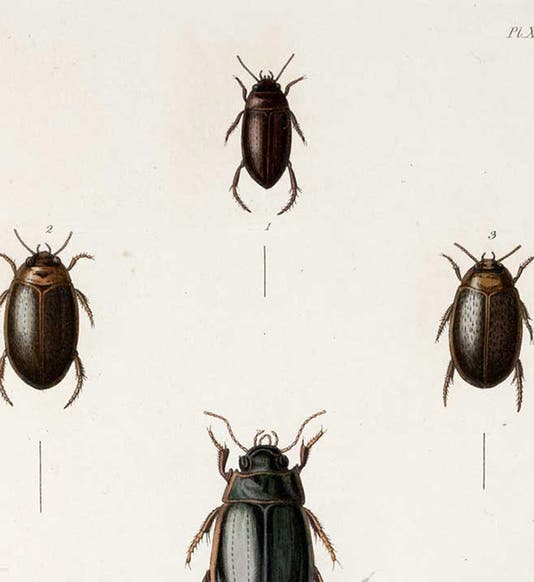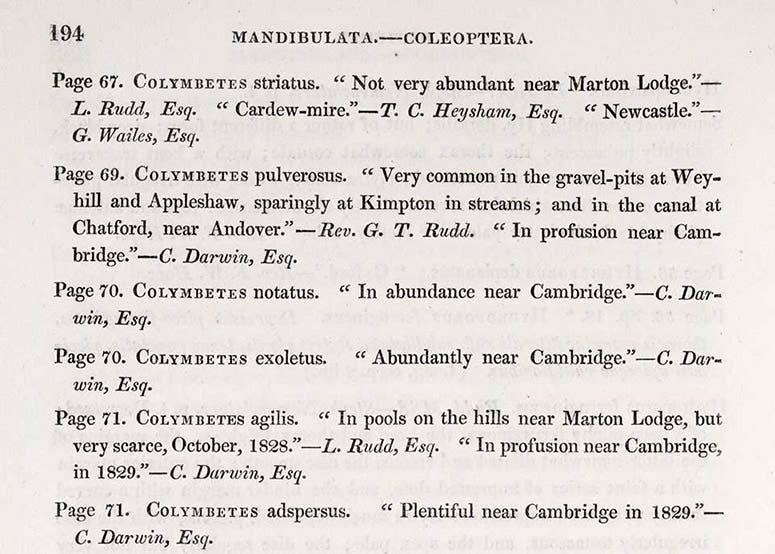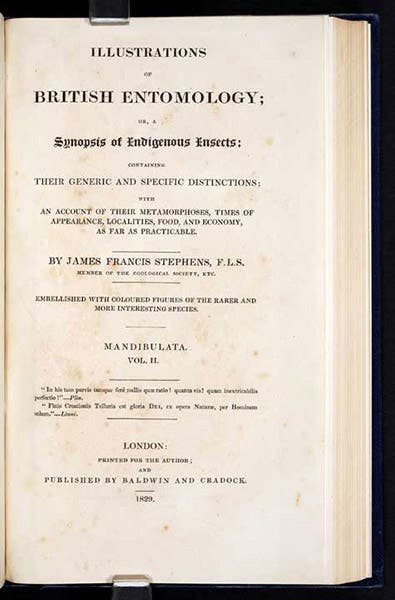Scientist of the Day - James Stephens
James Stephens, an English zoologist and entomologist, was born Sep. 16, 1792. Stephens worked for most of his life as a clerk for the British Admiralty at Somerset House in London, but he had from childhood an avid interest in birds, animals, and especially insects, which he began collecting early on. He contributed to George Shaw's General zoology, or Systematic Natural History (1800-26) and himself compiled the volumes on birds after Shaw's death. Stephens also helped catalog the insect collection at the British Museum in the 1820s.
In 1828, he began publishing his Illustrations of British Entomology, which would continue through 12 volumes until the final supplement in 1846. This is the only work by Stephens that we have in the Library, but it is just the right one, because of its connection with Charles Darwin.
The first volume of Stephens Illustrations described beetles. When it appeared, in 1828, Darwin had just enrolled at Cambridge University, and very soon he and his cousin William Darwin Fox were spending all their time (and I do mean all their time – Darwin hardly ever attended class that first year) collecting beetles. Stephens's Illustrations was issued in parts, as a serial, and Darwin began to subscribe. Soon he was sending off beetles and notes on beetles to Stephens. By the time volume 2 was being issued, in 1829, Stephens had begun to cite Darwin, in the appendix, as evidence that a particular species of beetle could be found in Cambridge.
We show here one of the plates from volume 2, which illustrates beetles in the genus Colymbetes (fourth image). And we include a detail of a page from the appendix, where Darwin is cited five times in this one half-page section (third image). Concerning Colymbetes pulverosis, Stephens adds: “ ‘In profusion near Cambridge’ – C. Darwin, Esq.” C. pulverosis is fig. 2 on the detail of the plate, the beetle at the left (first image). As to Colymbetes adspersus, Stephens notes: ” ‘Plentiful near Cambridge in 1829’ – C. Darwin, Esq.” C. adspersus is fig. 3 in the same plate, the right-hand beetle in the detail. None of the other beetles that Darwin commented on in this volume were illustrated.
Darwin met Stephens in London for tea in 1829. He wrote in a letter to Fox: “His cabinet is more magnificent than the most zealous Entomologist could dream of: He appears to be a very good-humoured pleasant little man." In 1833, when Darwin was in South America as part of the HMS Beagle voyage, he received a letter from Frederick W. Hope, the other prominent entomologist who befriended the young Darwin, telling Darwin that Hope and Stephens and several others had founded the Entomological Society of London, and he had enrolled Darwin as a member. He also informed Darwin that another entomologist had pirated the illustrations from Stephens’ book, and Stephens had taken him to court, with no satisfactory result except that Stephens had to pay some £400 in legal fees. Since he had no money, a subscription fund had been set up for Stephens. I was not able to find out if Darwin contributed to the fund, but I would not be surprised if he did, as it was a common practice of his to donate to such funds later in life, when he was settled at Down House.
Later in his own life, Darwin wrote a short autobiography, and he still recalled, in his old age, the flush of pleasure he felt at seeing his name in Stephens’ Illustrations. He also recalled a beetle-collecting incident that is one of the most famous passages in the autobiography. You can read about It in our post on yet another entomologist in Darwin’s life, Leonard Jenyns.
As far as I could determine, there is only the one photograph of Stephens, not a very good one, that shows him later in life (Stephens was 47 when photography was invented). Stephens died, still poor, in 1853. But his Illustrations, and his friendship with Darwin, is an excellent legacy.
Dr. William B. Ashworth, Jr., Consultant for the History of Science, Linda Hall Library and Associate Professor emeritus, Department of History, University of Missouri-Kansas City. Comments or corrections are welcome; please direct to ashworthw@umkc.edu.










